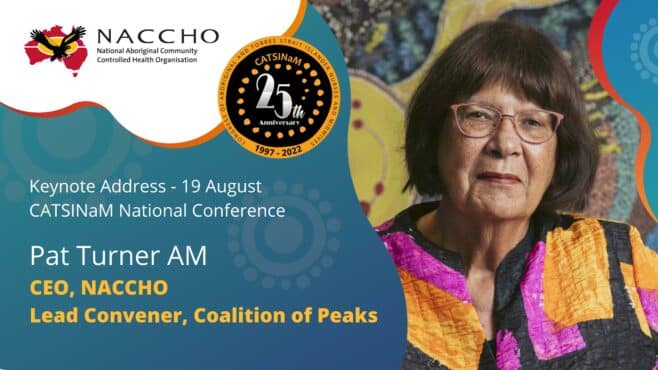

It is time governments front up to their failure to Aboriginal and Torres Strait Islander people
Pat Turner
A core tenant of Australia’s modern national identity is belief in a fair go. Yet the promise of a fair go is not a reality for everyone in this country. The difference in the life outcomes of First Nations people compared to the rest of Australia is stark.
There is more than just a gap, it is a chasm, a gaping wound on the soul of our nation. Collectively, we need to call this out, be truthful about the failure of governments and how we got here, so that we can chart a new and honest way forward.
A decade ago, governments committed themselves to closing this gap but year after year the prime minister has stood up in parliament seemingly contented with the reported failures.
Governments have misled the public by painting the lack of progress on the targets as something outside of their control, and not something that is a direct result of their policy failings. Busy talking up the steps they were taking to close the gap, at the same time as ripping funding from dedicated Aboriginal and Torres Strait Islander programs and services and silencing our voices. Isolated case studies of ‘success’ are used to project a sense of change across the nation, when the reality is that the majority of Aboriginal and Torres Strait Islanders continue to experience poor life outcomes and hardship in their daily lives.
It’s no wonder then that many Aboriginal and Torres Strait Islander people have lost faith in the Closing the Gap framework – it has failed to deliver meaningful change and was designed without their formal involvement.
This cycle of failure is toxic. It breeds cynicism and complacency, with nobody wanting to take ownership. Enough is enough. It is time to end the cycle with a serious circuit breaker.
That’s why a group of Aboriginal and Torres Strait Islander community-controlled organisations came together late in 2018 and wrote to the Prime Minister, Premiers and Chief Ministers, rejecting the so called “Refresh” and calling for a genuinely new approach. The Council of Australian Governments (COAG) had already started work on a new Closing the Gap framework for the next decade, following the same doomed processes.
A lot of ground has been broken over the past year that can help put this cycle of failure to bed. We have more Aboriginal and Torres Strait Islander people in Australian parliaments than ever before, an Aboriginal Treasurer in Western Australian, Aboriginal Ministers in the Northern Territory; a Federal Aboriginal Minister for Indigenous Australians who is a member of Cabinet; and an Aboriginal Federal Opposition Spokesperson for Indigenous Affairs.
And we finally have a formal structure that puts Aboriginal and Torres Strait Islander leaders of community-controlled organisation at the negotiating table with governments on Closing the Gap. A formal partnership agreement was signed by COAG and our group of community-
controlled organisations, collectively called the Coalition of Peaks. This historic partnership gives Aboriginal and Torres Strait Islander people shared decision-making power with governments to develop, implement, monitor and review Closing the Gap policies for the next ten years.
Never have leaders of Aboriginal and Torres Strait Islander community-controlled peak bodies from across the country come together in this way: to bring their collective expertise, experiences and deep understanding of the needs of our people to the task of closing the gap; and never has there been this level of Aboriginal and Torres Strait Islander representation in parliaments and government decision making positions.
However, this week is not the week for celebration. Having a position in Cabinet or a seat at the negotiating table is not the end game. We should not be judged on the accumulation of power but how we choose to use that power.
The Coalition of Peaks are living up to their side of the agreement, fiercely representing the views of Aboriginal and Torres Strait Islander people on what is needed to close the gap; and proposing policies that, if fully implemented, will lead to improvements in our people lives.
What we heard overwhelmingly through our comprehensive community engagement process is that structural reform is far more critical than targets. We must ensure the full involvement of Aboriginal and Torres Strait Islander peoples in shared decision-making at national, state, local and regional levels. We must also support Aboriginal and Torres Strait islander people to control and deliver the programs and services our communities need. And finally, we need Australian governments to contribute through structural changes to mainstream and government-funded services, such as universities, hospitals and policing and courts.
Governments say that they are listening and support the Priority Reforms. But listening is more than a nod of the head, it requires the Priority Reforms to be translated into tangible, properly funded, actions that deliver real benefit to Aboriginal and Torres Strait Islander people no matter where they live.
The current cycle of failure is doomed to continue if this process of engagement and partnership is nothing more than window dressing for the status quo. The only way outcomes for my people will change is when governments are willing to challenge the structures and assumptions that got us here and embedded the disadvantage of Aboriginal and Torres Strait Islander people.
Change is never easy but with the right leadership it is possible. So, if our leaders step up and deliver, we may finally begin a new cycle success and a fair go for First Nations people.
Patricia Turner AM, is CEO of NACCHO and Lead Convenor of the Coalition of Peaks

